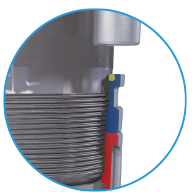For brewers, cleanliness in filling is afforded the utmost attention. It is imperative as the product should reach the beer drinker with exactly the same degree of freshness it left the brewery in. In order to avoid defects in quality and the dreaded ullage or remaining beer as far as possible, KHS is committed in development of its machines to continuously improving standards of hygiene – right down to the last detail.
One good example of this is the new crowner which was presented at the last BrauBeviale trade show in Nuremberg, Germany. As the part of the machine which always comes into contact with residual beer, the crowner is a critical element when it comes to hygiene and one which is always subject to a certain risk of contamination.
As in all areas of beer filling, when capping bottles it’s important that air be kept from entering the bottles to the greatest possible extent. The oxygen in the air is considered to be beer’s greatest enemy as it causes oxidative change. This causes the beer to lose its hop bouquet after a certain time as well as some of its richness of flavor; it also develops an unwanted aging taste which is perceived as tasting bready or cardboardy. All told, oxygen also objectively shortens a beer’s shelf life – something neither brewers nor customers like.
It’s extremely important to prevent oxygen from penetrating beer bottles especially in conjunction with often decidedly hoppy craft beers and what are known as draft beers which should taste as if they’ve just been tapped from the barrel. Unlike most other beer styles, where the capped bottles are heated to a temperature of 65°C in the tunnel pasteurizer, pasteurized, and recooled, the makers of craft and draft beers do without heat treatment wherever possible as this always takes up time and energy on the one hand and usually alters the taste on the other. Sensitive palates notice a touch of maltiness or what’s called a burned taste. Doing without antibacterial post-processing, increases the demands made of hygiene for both the filler and the crowner considerably in order to achieve the desired shelf life without the beer hazing.
A number of measures are thus taken during beer production to keep oxygen out of the product. Prior to crowning, for instance, the beer is deliberately made to foam through high-pressure injection. The rising foam displaces the oxygen so that when placed on the bottle the crown cork is purged with foam and is therefore no longer filled with air before the die ring pulls it over the bottle neck. Unavoidable during this process is the infiltration of beer in the mechanical components of the crowner. In order for the crowner element to nevertheless remain microbiologically clean and not contaminate the beer bottles passing through, it must be continuously and thoroughly sanitized and flushed.
Five new plus points
Here, it’s important that the capping ring and all of the crowner’s mechanical equipment are made as accessible as possible to the rinsing media and that they permit the maximum heat input needed to kill germs. The KHS crowner chalks up no less than five innovations in this respect.
The new crowner has been developed by a team headed by Manfred Härtel, filling product manager at KHS. He talks about the further benefits the innovation entails. “By removing material we’re increasing permeability. This boosts microbial safety and shortens sanitizing times without having to compromise on the function or stability of the workpiece whatsoever.” But that’s not all. “We haven’t changed anything in the actual design or dimensions. The element can be easily retrofitted into existing crowners using a conversion kit,” explains Härtel. The new design will be incorporated in future systems as standard beginning the second half of the year.
Great interest, positive echo
Not only craft and draft beers profit from these improvements; non-alcoholic beers, which are hygienically even more sensitive as they don’t have the sterilizing effect of alcohol, also benefit. The interest in hygienic improvements is thus great within the industry, with the crowner reaping a very positive response at the trade show. Härtel is pleased. “The crowner is a critical element as it constantly has to operate in an environment of beer residue. Some customers repeatedly have problems in this area; we can greatly improve and alleviate this situation. Brewers can again sleep more easily and worry less about quality defects in their products.” But this is just the beginning; the crowner is, so to speak, the start of a full hygienic redesign in beer filling. “This element is just one of many we’re going to tackle,” promises Härtel.
Your contact on this topic
Manfred Härtel
Filling product manager
KHS GmbH, Bad Kreuznach, Germany
Phone: +49 671 852-2644
Email: manfred.haertel@khs.com


























